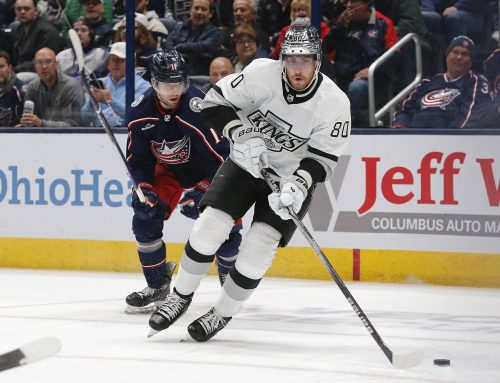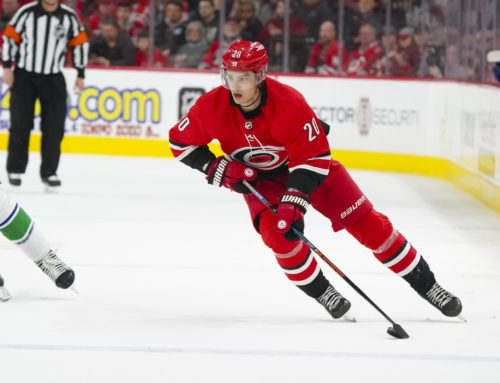Daily Fantasy Winning Lineups Recap
Stephen Dotzel
2022-03-03
With some extra free time on my hands this past week, I decided to comb through the results of some daily fantasy tournaments I participated in over the past month. This is an exercise I did frequently when I just stared playing DFS, but has been something I've gotten away from of late. With some poor results over the past few weeks, I thought this was a good time to get back to the basics.
My objective was simple: Capture the winning lineup from each day and plot it in Excel. From there I could try and spot any trends that emerged or gather some takeaways that I could then apply to my own lineups in the future. I'll share what I found below.
But first for reference, the lineups I reviewed were 23 first-place lineups from the DraftKings $4 Forecheck tournament from the main slate on days between 1/24/22 and 2/23/22. That tournament typically has between 2,900 and 4,500 entries and has a 20-lineup maximum per person entry limit. That combination of a large field and low dollar buy in amount with a top heavy payout of four figures makes this a tournament that appeals to both a novice and more experienced player looking to turn a small amount into a nice payday.
While 23 lineups/days isn't a huge sample, I think it's large enough to be material. For the purpose of this article, when I say "stack," I am referring to a group of players from the same team. So what patterns, if any, did the lineups have in common? Let's take a look.
LINEUP CONSTRUCTION
Of the 23 1st place lineups:
- 1 lineup had a 6-player stack
- 2 lineups had a 5+ player stack
- 1 was exactly 5 players, 1 was 6 players
- 13 lineups had a 4+ player stack
- 11 was exactly 4 players, 1 was 5 players, 1 was 6 players
- 21 lineups had a 3+ player stack
- 8 was exactly 3 players, 11 was 4 players, 1 was 5 players, 1 was 6 players
Lineup Construction Takeaway
With 21 of the 23 1st place lineups having at least one 3-player stack in them, I think making a set rule that every lineup you make should have a 3-man stack is certainly valid. I also think it's worth expanding that stack to 4 as 11 of the 23 lineups, just shy of 50%, contained a 4-player stack. Let's look into these stacks a little further.
Lineups With a 4-Player Stack
Of the 11 1st place lineups that contained a 4-player stack, eight had a format of 4-3-1. That means they had a 4-player stack from one team, a 3-player stack from a second team, and a one-off player from a third team to fill the last spot. Interestingly in all eight of those lineups, the one-off player was a defenseman.
Of the 11 first-place lineups that contained a 4-player stack, 10 of the 4-player stacks contained a Line 1 center and a Line 1 winger.
Of the 11 first-place lineups that contained a 4-player stack, 9 of the 4-player stacks contained a defenseman. 7 of those 9 were on Power Play 1.
The average combined price of the 4-player stacks was $21,250 and the average ownership percentage for the players in the 4-player stacks was 7.6%. That price tag and ownership number are both quite low. With an average player salary of around $5,300 this shows the 4 player stacks used are not necessarily the big guns you may be thinking. This makes sense as a stack of say Nathan MacKinnon, Mikko Rantanen, Gabriel Landeskog, and Cale Makar sounds good in theory, but it will likely cost you close to $30,000 and severely hamper the rest of your lineup. Focusing on more "middle of the pack" stacks for your 4-player stacks will help with the price and in turn likely put you on lower owned players by default.
Lineups With a 3-Player Stack
Of the eight first-place lineups that contained a stack of exactly three players as its largest, five of those stacks contained another 3-player stack. The other three stacks of the eight contained another 2-player stack.
4-Player and 3-Player Stack Takeaway
The 4-player stack lineups painted a pretty clear picture. Those winning lineups stacked a Line 1 center, Line 1 winger, power play defenseman (often Power Play 1) with a fourth player that was either the other winger from Line 1 or a Line 2 Power Play 1 forward.
The 3-player stack lineups weren't as clear in their structure, but they all contained at least a second stack of at least 2 players with the majority having a second 3-player stack. Similarly to the 4-player stacks, a Line 1 center with a Line 1 winger was most common with either a power-play defenseman or Line 1/Power Play 1 forward as the third player.
POSITIONAL USAGE
In the 19 first-place lineups where a 4 player or 3 player stack was used, 39 centers were used.
- 36 centers were on Power Play 1
- 24 centers were on Line 1
- 11 centers were on Line 2
In the 19 first-place lineups where a 4 player or 3 player stack was used, 75 wingers were used
- 73 wingers were on a Power Play
- 55 wingers were on Power Play 1
- 18 wingers were on Power Play 2
- 46 wingers were on Line 1
- 25 wingers were on Line 2
In the 19 first-place lineups where a 4 player or 3 player stack was used, 38 defensemen were used
- 35 defenseman were on a Power Play
- 24 defenseman were on Power Play 1
- 11 defenseman were on Power Play 2
In the 21 first-place lineups where a 3+ player stack was used, a goalie from one of those teams that were stacked was used seven times.
Positional Usage Takeaways
92% of the centers used in the winning lineups I looked at were on the first power play. That is high enough number for me to rule out all other centers from my play pool when building lineups.
97% of the wingers used in the winning lineups I looked at were on a power play, but not necessarily the first. That is a large enough number for me to remove any winger not on a power play from my player pool when building lineups. The split between Power Play 1 and Power Play 2 was 75%-25% so unlike center, I will keep Power Play 2 wingers in my pool though they should be limited to about one per lineup.
95% of the wingers used in the winning lineups I looked at were on Line 1 or Line 2. That is a large enough number for me to remove any winger beyond Line 2 from my player pool when building lineups.
92% of the defenseman used in the winning lineups I looked at were on a power play, but not necessarily the top unit. Like the other positions that is a large enough number for me to remove any defenseman not on a power play from my player pool when building lineups. The split between Power Play 1 and Power Play 2 was 69%-31%.
Given these numbers, between the eight lineup spots available (2 centers, 3 wingers, 2 defenseman, 1 flex) I feel both centers must be Power Play 1 and of the remaining six spots, at least four should be Power Play 1.
33% of the goalies used in the winning lineups I looked at were added on to one of the team stacks within that lineup. That number is low enough that I do not think it is necessary to include your goalie in your stack.
SUMMARY
So if you're still reading this, God bless you. You must be as bored as I was when I put this together. All said and done, I came away from this experiment reaffirmed in my belief that stacking is the path to winning NHL DFS tournaments. However, the players in those stacks and how they're built did change a little for me.
It's of my belief that stacks of 4-3-1, 3-3-2, or 3-3-1-1 are the superior lineup construction for winning tournaments. These builds accounted for 57% of the winning lineups, which while that's not an overwhelming number, it is a clear majority.
I knew the power play was important but I didn't quite understand how important, but the numbers speak for themselves. It's so rare that a player not on a power play makes the winning lineup, it's of my opinion that those players are not even worth considering rostering. This is even truer at center where the pool of players can be shrunken even further to Power Play 1 only.
LINEUP EXAMPLES
Given everything I just said, here are two example lineups.
Lineup #1 4-3-1 Stack
Team A: Line 1 Center*, Line 1 Winger*, Line 1 Winger**, Defenseman*
Team B: Line 1 Center*, Line 1 Winger**, Line 2 Winger*
Team C: Defenseman**
Goalie: Best Available
*Power Play 1
**Power Play 2
Lineup #2 3-3-2 Stack
Team A: Line 1 Center*, Line 1 Winger*, Defenseman*
Team B: Line 1 Center*, Line 1 Winger**, Line 2 Winger*
Team C: Line 2 Winger*, Defenseman**
Goalie: Best Available
*Power Play 1
**Power Play 2
I think this is a good place to put a fork in this article and digest this information. Of course, while these suggestions are based on data over the past month that does not mean the next month will follow the same patterns. Ultimately, how you choose to use any of this is up to you. I will be continuing to track winning lineups for at least the next month to see if these trends continue. Whether you found this article interesting or boring, I hope you can take something away from it that makes you a better DFS player.





 WSH
WSH NYR
NYR NSH
NSH VAN
VAN COL
COL WPG
WPG L.A
L.A EDM
EDM CHI
CHI T.B
T.B CAR
CAR NYI
NYI MIN
MIN
